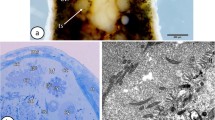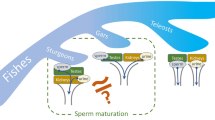Summary
The ductus epididymidis of the tammar is lined by an epithelium composed of principal, mitochondria-rich, apical and basal cells, and intraepithelial leucocytes. The epithelium is structurally differentiated into 6 zones referred to as the initial segment, middle segment (3 subdivisions) and terminal segment (2 subdivisions). The occurrence of the initial, middle and terminal segments corresponds quite closely to the anatomical differentiation of the epididymis into a head, body and tail.
The initial segment epithelium in the tammar is lower and has shorter and more slender stereocilia than in other mammals which have been described. Otherwise, the structure of the epithelium has similar characteristics in the tammar to that described in other mammals.
Spermatozoa begin to develop the capacity for motility within the initial segment, but only show structural signs of maturation in the middle segment. The sperm head rotates through 90 degrees in the proximal subdivision of the middle segment. The cytoplasmic droplet is detached and spermatozoa develop the capacity for motility in the middle subdivision of the middle segment. The cytoplasmic droplets are phagocytosed by the epididymal epithelium of the middle segment. Sperm storage appears to be the main function of the terminal segment.
Similar content being viewed by others
References
Alsum DJ, Hunter AG (1978) Regional histology and histochemistry of the ductus epididymidis in the Rhesus monkey (Macaca mulatta). Biol Reprod 19:1063–1069
Bedford JM (1977) Evolution of the scrotum: the epididymis as the prime mover? In: JH Calaby, CH Tyndale-Biscoe (ed) Reproduction and evolution. Australian Academy Science, Canberra, pp 171–182
Bedford JM (1979) Evolution of the sperm maturation and sperm storage functions of the epididymis. In: Fawcett DW, Bedford JM (eds) The spermatozoon maturation, motility, surface properties and comparative aspects. Urban and Schwarzenberg, Baltimore, pp 7–21
Benoit J (1926) Recherches anatomiques, cytologiques et histophysiologiques sur les voies excrétices du testicule, chez les mammifères. Arch Anat Histol Embryol 5:173–412
Brooks DE, Higgins SJ (1980) Characterization and androgen dependence of proteins associated with luminal fluid and spermatozoa in the rat epididymis. J Reprod Fertil 59:363–375
Brooks DE, Hamilton DW, Mallek AH (1973) The uptake of L-(methyl-3H) carnitine by the rat epididymis. Biochem Biophys Res Comm 52:1352–1360
Brooks DE, Gaughwin M, Mann T (1978) Structural and biochemical characteristics of the male accessory organs of reproduction in the hairy-nosed wombat (Lasiorhinus latifrous) Proc R Soc Lond B 201:191–207
Brown D, Montesano R (1980) Membrane specialization in the rat epididymis. I. Rod-shaped intramembrane particles in the apical (mitochondria-rich) cell. J Cell Sci 45:187–198
Cameo MS, Blaquier JA (1976) Androgen controlled specific proteins in rat epididymis. J Endocrinol 69:47–55
Crabo BO (1965) Studies on the composition of epididymal content in bulls and boars. Acta Vet Scand 6 (Suppl 5): 1–94
Cummins JM (1976) Epididymal maturation of spermatozoa in the marsupial Trichosurus vulpecula: changes in motility and gross morphology. Aust J Zool 24:499–511
Dawson RMC, Mann T, White IG (1957) Glycerylphosphorylcholine and phosphorylcholine in semen, and their relation to choline. Biochem J 65:627–634
Djakiew D, Jones RC (1981) Structural differentiation of the male genital ducts of the echidna (Tachyglossus aculeatus) J Anat 132:187–202
Djakiew D, Jones RC (1982a) Ultrastructure of the ductus epididymidis of the echidna, Tachyglossus aculeatus. J Anat 135:625–634
Djakiew D, Jones RC (1982b) Stereological analysis of the epididymis of the echidna, Tachyglossus aculeatus, and Wistar rat. Aust J Zool 30:865–875
Djakiew D, Jones RC (1983) Sperm maturation, fluid transport, and secretion and absorption of proteins in the epididymis of the echidna, Tachyglossus aculeatus. J Reprod Fertil 68:445–456
Emmens CW (1947) The motility and viability of rabbit spermatozoa at different hydrogen ion concentrations. J Physiol 106:471–481
Entwistle KW (1972) Congo red-fast green FCF as a supra-vital stain for ram and bull spermatozoa. Aust Vet J 48:515–519
Fawcett DW, Hoffer A (1979) Failure of exogenous androgen to prevent regression of the initial segments of the rat epididymis after efferent duct ligation or orchidectomy. Biol Reprod 20:162–181
Flickinger CJ, Howards SS, English HF (1978) Ultrastructural differences in efferent ducts and several regions of the epididymis of the hamster. Am J Anat 152:557–586
Forssmann WG, Ito S, Weihe E, Aoki A, Dym M, Fawcett DW (1977) Improved perfusion fixation method for the testis. Anat Rec 188:307–314
Glauert AM, Glauert RH (1958) Araldite as an embedding medium for electron microscopy. J Biophys Biochem Cytol 4:191–194
Glover TD, Nicander L (1971) Some aspects of structure and function in the mammalian epididymis. J Reprod Fertil (Suppl) 13:39–50
Hamilton DW (1975) Structure and function of the epithelium lining the ductuli efferentes, ductus epididymidis and ductus deferens in the rat. In: Greep RO, Astwood EB (eds) Handbook of physiology Sect 7, Vol 5, Am Physiol Soc, Washington DC, pp 259–301
Hammar JA (1897) Über Secretionserscheinungen im Nebenhoden des Hundes. Arch Anat Entwick-Gesch Suppl 1:1–42
Harding HR, Carrick FN, Shorey CD (1975) Ultrastructural changes in spermatozoa of the brush-tailed possum, Trichosurus vulpecula (Marsupialia), during epididymal transit, Part 1: The flagellum. Cell Tissue Res 164:121–132
Harding HR, Carrick FN, Shorey CD (1976) Ultrastructural changes in spermatozoa of the brush-tailed possum, Trichosurus vulpecula (Marsupialia), during epididymal transit. Part II: The acrosome. Cell Tissue Res 171:61–73
Hoffer AP, Greenberg J (1978) The structure of the epididymis, efferent ductules and ductus deferens of the guinea pig: a light microscope study. Anat Rec 190:659–678
Hoffer AP, Hamilton DW, Fawcett DW (1973) The ultrastructure of the principal cells and intraepithelial leucocytes in the initial segment of the rat epididymis. Anat Rec 175:169–202
Holstein A-F (1969) Morphologische Studien am Nebenhoden des Menschen. In: W. Bargmann, W. Doerr (eds) Zwanglose Abhandlungen aus dem Gebiet der normalen und pathologischen Anatomie. G. Thieme, Stuttgart, pp 77–91
Humason GL (1972) Animal tissue techniques W.H. Freeman and Company, San Francisco
Jenkins AD, Lechene CP, Howards SS (1980) Concentrations of seven elements in the intraluminal fluids of rat seminiferous tubules, rete testis and epididymis. Biol Reprod 23:981–987
Jones R, Hamilton DW, Fawcett DW (1979) Morphology of the epithelium of the extratesticular rete testis, ductuli efferentes and ductus epididymidis of the adult male rabbit. Am J Anat 156:373–400
Jones R, Brown CR, von Glos KI, Parker MG (1980) Hormonal regulation of protein synthesis in the rat epididymis. Biochem J 188:667–676
Jones RC (1980) Luminal composition and maturation of spermatozoa in the genital duct of the African elephant Loxodonta africana. J Reprod Fertil 60:87–93
Jones RC, Brosnan MF (1981) Studies of the deferent ducts from the testis of the African elephant, Loxodonta africana. I. Structural differentiation. J Anat 132:371–386
Koskimies AI, Kormano M (1975) Proteins in fluids from different segments of the rat epididymis. J Reprod Fertil 43:345–348
Levine N, Marsh DJ (1971) Micropuncture studies of the electrochemical aspects of fluid and electrolyte transport in individual seminiferous tubules, the epididymis and the vas deferens in rats. JPhysiol 213:557–570
Nicander L (1957) On the regional histology and cytochemistry of the ductus epididymidis in rabbits. Acta Morph Neerlando-Scandin 1:99–118
Nicander L (1958) Studies on the regional histology and cytochemistry of the ductus epididymidis in stallions, rams and bulls. Acta Morph Neerlando-Scandin 1:337–362
Nicander L (1979) Fine structure of principal cells in the initial segment of the epididymal duct in the ram. Z Veter Reihe C: Anat Histol Embryol 8:318–330
Nicander L, Glover TD (1973) Regional histology and fine structure of the epididymal duct in the golden hamster. (Mesocricetus auratus) J Anat 114:347–364
Nicander L, Malmquist M (1977) Ultrastructural observations suggesting merocrine secretion in the initial segment of the mammalian epididymis. Cell Tissue Res 184:487–490
Nicander L, Ploen L (1979) Studies on regional fine structure and function in the rabbit epididymis. Int J Androl 2:463–481
Orgebin-Crist M-C (1973) Maturation of spermatozoa in the rabbit epididymis: effect of castration and testosterone replacement. J Exp Zool 185:301–310
Orsi AM, de Mello VR, Ferreira AL, Campos VJM (1980) Morphologie des cellules épithéliales du canal de l'epididyme de l'opossum (Sarigue) sug-americain (Didelphis azarae). Anat Anz Jena 148:7–13
Orsi AM, Ferreira AL, de Mello VR, Oliveira MO (1981) Regional histology of the epididymis in the South American opossum. Light microscope study. Anat Anz Jena 150:521–528
Ramos AS, Dym M (1977) Fine structure of monkey epididymis. Am J Anat 149:501–532
Reid BL, Cleland KW (1957) The structure and function of the epididymis I. The histology of the rat epididymis. Aust J Zool 5:223–246
Reynolds ES (1963) The use of lead citrate at high pH as an electron-opaque stain in electron microscopy. J Cell Biol 17:208–212
Setchell BP (1977) Reproduction in male marsupials. In: Stonehouse, B, Gilmore D (eds) The biology of marsupials. Macmillan, London, pp 411–455
Setchell BP, Carrick FN (1973) Spermatogenesis in some Australian marsupials. Aust J Zool 21:491–499
Setchell BP, Hinton BT (1981) The effects on the spermatozoa of changes in the composition of luminal fluid as it passes along the epididymis. In: C Bollack, A Clavert (eds) Progress in reproductive biology 8. Epididymis and fertility: Biology and pathology. S. Kager, Basel München Paris London New York Sydney, pp 58–66
Setchell BP, Dawson RMC, White RW (1968) The high concentration of free inositol in rete testis fluid from rams. J Reprod Fertil 17:219–220
Sun EL, Flickinger CJ (1979) Development of cell types and of regional differences in the post-natal rat epididymis. Am J Anat 154:27–56
Sun EL, Flickinger CJ (1980) Morphological characteristics of cells with apical nuclei in the initial segment of the adult rat epididymis. Anat Rec 196:285–293
Suzuki F, Racey PA (1976) Fine structural changes in the epididymal epithelium of moles (Talpa europaea) J Reprod Fertil 47:47–54
Temple-Smith PD, Bedford JM (1976) The features of sperm maturation in the epididymis of a marsupial, the brushtailed possum Trichosurus vulpecula. Am J Anat 147:471–500
Temple-Smith PD, Bedford JM (1980) Sperm maturation and the formation of sperm pairs in the epididymis of the opossum, Didelphis virginiana. J Exp Zool 214:161–171
Umbreit WW, Burris RH, Stauffer JF (1972) Manometric and biochemical techniques. 5th edn. Burgess Pub Co Minneapolis, p 146
Watson ML (1958) Staining of tissue sections for electron microscopy with heavy metals. J Biophys Biochem Cytol 4:475–478
Author information
Authors and Affiliations
Rights and permissions
About this article
Cite this article
Jones, R.C., Hinds, L.A. & Tyndale-Biscoe, C.H. Ultrastructure of the epididymis of the tammar, Macropus eugenii, and its relationship to sperm maturation. Cell Tissue Res. 237, 525–535 (1984). https://doi.org/10.1007/BF00228437
Accepted:
Issue Date:
DOI: https://doi.org/10.1007/BF00228437




